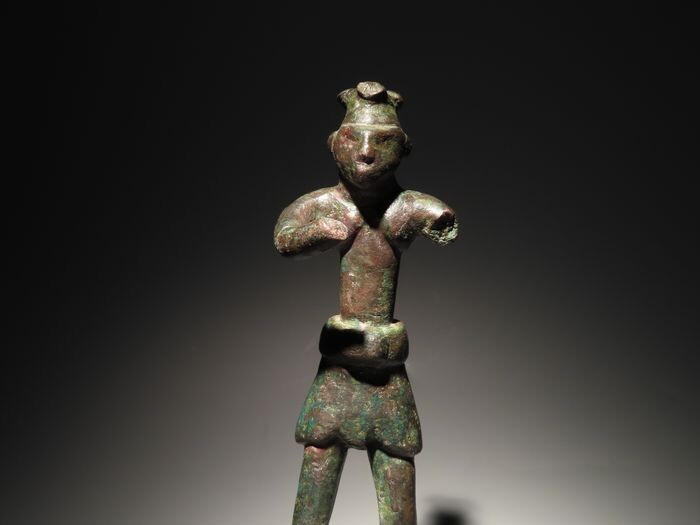Elamite Bronze Solid. Important figure of a deity. 16 cm H.
Important Elamite figure of a deity. Elamite Culture. 2nd Millenium BC Bronze, solid cast. 16 cm Height, 17 with it's modern stand. PROVENANCE: Pricate collection, UK, until 2017. Adcquired in 1966. CONDITION: Overall good condition, unrestored. DESCRIPTION: Elam was an ancient civilization centered in the far west and southwest of modern-day Iran, stretching from the lowlands of what is now Khuzestan and Ilam Province as well as a small part of southern Iraq. The modern name Elam stems from the Sumerian transliteration elam, along with the later Akkadian elamtu, and the Elamite haltamti. Elamite states were among the leading political forces of the Ancient Near East. In classical literature, Elam was also known as Susiana, a name derived from its capital Susa. Elam was part of the early urbanization during the Chalcolithic period (Copper Age) . The emergence of written records from around 3000 BC also parallels Sumerian history, where slightly earlier records have been found. In the Old Elamite period (Middle Bronze Age) , Elam consisted of kingdoms on the Iranian plateau, centered in Anshan, and from the mid-2nd millennium BC, it was centered in Susa in the Khuzestan lowlands. Its culture played a crucial role during the Persian Achaemenid dynasty that succeeded Elam, when the Elamite language remained among those in official use. Elamite is generally considered a language isolate unrelated to any other languages. In accordance with geographical and archaeological matches, some historians argue that the Elamites comprise a large portion of the ancestors of the modern day Lurs whose language, Luri, split from Middle Persian. Notes: The seller guarantees that he acquired this piece according to all national and international laws related to the ownership of cultural property. Provenance statement seen by Catawiki. The piece includes authenticity certificate. The piece includes Spanish Export License (Passport for European Union) - If the piece is destined outside the European Union a substitution of the export permit should be requested. This process could take between 1 and 2 months.
[ translate ]View it on
Estimate
Time, Location
Auction House
Important Elamite figure of a deity. Elamite Culture. 2nd Millenium BC Bronze, solid cast. 16 cm Height, 17 with it's modern stand. PROVENANCE: Pricate collection, UK, until 2017. Adcquired in 1966. CONDITION: Overall good condition, unrestored. DESCRIPTION: Elam was an ancient civilization centered in the far west and southwest of modern-day Iran, stretching from the lowlands of what is now Khuzestan and Ilam Province as well as a small part of southern Iraq. The modern name Elam stems from the Sumerian transliteration elam, along with the later Akkadian elamtu, and the Elamite haltamti. Elamite states were among the leading political forces of the Ancient Near East. In classical literature, Elam was also known as Susiana, a name derived from its capital Susa. Elam was part of the early urbanization during the Chalcolithic period (Copper Age) . The emergence of written records from around 3000 BC also parallels Sumerian history, where slightly earlier records have been found. In the Old Elamite period (Middle Bronze Age) , Elam consisted of kingdoms on the Iranian plateau, centered in Anshan, and from the mid-2nd millennium BC, it was centered in Susa in the Khuzestan lowlands. Its culture played a crucial role during the Persian Achaemenid dynasty that succeeded Elam, when the Elamite language remained among those in official use. Elamite is generally considered a language isolate unrelated to any other languages. In accordance with geographical and archaeological matches, some historians argue that the Elamites comprise a large portion of the ancestors of the modern day Lurs whose language, Luri, split from Middle Persian. Notes: The seller guarantees that he acquired this piece according to all national and international laws related to the ownership of cultural property. Provenance statement seen by Catawiki. The piece includes authenticity certificate. The piece includes Spanish Export License (Passport for European Union) - If the piece is destined outside the European Union a substitution of the export permit should be requested. This process could take between 1 and 2 months.
[ translate ]


